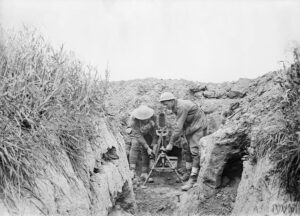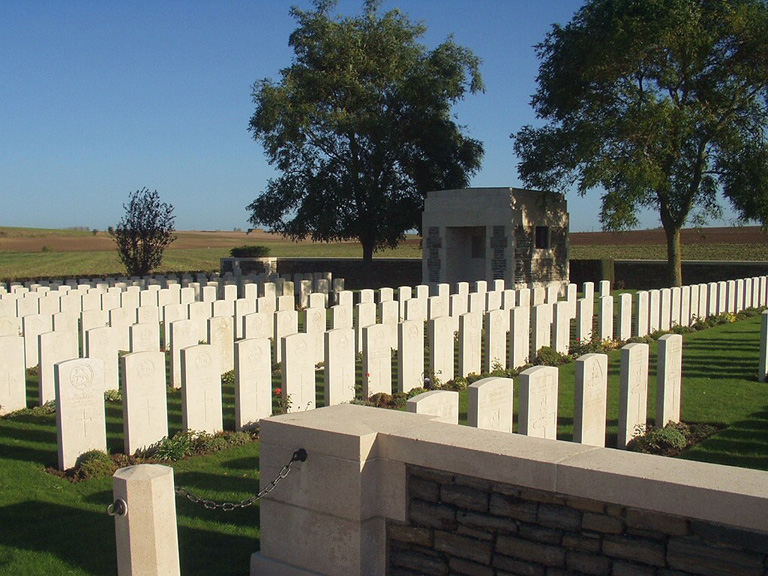Name & Rank: Private Charles White

Australian Trench Mortarmen set up the stokes gun. Charles White would have served an identical weapon IWM (E(AUS) 2677) Link.
Regimental Number: G/68637
Birth date & Location: Born in 1899 in Chelsea, Middlesex, United Kingdom.
Foster-Parents: Frederick and Louisa Jane Yates
Family Profile: Charles White was born an orphan in 1899 in Middlesex. Adoption laws would not be enacted in England and Wales until 1926, before this, adoption was facilitated by charitable organizations or confirmed between two private individuals. Orphans often came under the supervision of the Board of Guardians, the same body that administered the English Poor Law system from 1835-1930. The Board of Guardians, along with private organizations like the National Society for the Prevention of Cruelty to Children undertook the administration of orphans. Few documents record Charles White’s early life, but we may safely assume that he was adopted by Frederick and Louisa Yates of Belmont Surrey.
Service Profile: Charles White enlisted in 1917 in Hounslow, Middlesex, not far from where he lived in Hampton Wick. He was assigned to the 8th Battalion Queen’s Royal West Surrey Regiment. At some point, Charles White was assigned to the 17th Light Trench Mortar Battery (T.M.B.). Trench Mortar Batteries were assigned to infantry units at the brigade level, and the 17th T.M.B. served alongside the 17th Brigade, of which the 8th Queen’s was part. Trench Mortar Batteries were manned by men assigned from the infantry battalions of the infantry brigade.
On 12 October, 1918, the 17th Brigade, with the 8th Queen’s and 17th T.M.B. working alongside one another, attacked the bridges and crossings over the Oise River near Rieux, France. A daring night attack was planned, with elements of the 8th Queen’s, 3rd Rifle Brigade, and 1st Royal Fusiliers, each supplemented by mortars and crews assigned from the 17th T.M.B. were sent to the river and across to establish a secure beach head. During the attack, the 17th Brigade endured a heavy artillery bombardment. It is likely that during this time that Charles White was wounded, dying shortly thereafter. The operation, however, was an unmitigated success, and the commander of the 17th Brigade praised the attack as “a valuable tactical success.” Although tragically near the end of the war, these small actions on the Selle river helped accelerate the collapse of the German Army on the Western Front, and eventually securing military victory for the allies. It was a period of unprecedented military success for the British Army during the First World War, and it could not have occurred in a more appropriate location. Rieux is just south of Agincourt, the site of Henry V’s famous victory over the French Crown in October of 1415, nearly 503 years before Charles White’s death, almost to the day.
Death date & Location: Charles White died of wounds on 12 October, 1918 in Rieux, France. He was buried in the St. Aubert British Cemetery in Philosophe, France.

ST. AUBERT BRITISH CEMETERY – CWGC
Sources:
“Adopted Children.” 10 June, 1905, West Surrey Times. (Surrey, England). The British Newspaper Archive. Link.
“Social Conditions – The Board of Guardians.”Powys, A Day in the Life. Powys County Archives. Link.
Surrey, England, Electoral Registers, 1832-1962 for Louisa Jane Yates. Epsom, Spring 1923. Surrey History Centre.
War Diary of the 8th Queen’s Royal West Surrey Regiment, 1914-1918. October, 1918. Queen’s Royal West Surrey Regiment.
Keegan, John. The Face of Battle: A Study of Agincourt, Waterloo, and the Somme. (London: Pimlico, 1975).
Military-Genealogy.com, comp. UK, Soldiers Died in the Great War, 1914-1919 [database on-line]. Provo, UT, USA: Ancestry.com Operations Inc, 2008.
White, Charles. Queen’s Royal West Surrey Regiment. G/68637. British Army World War I Medal Rolls Index Cards, 1914-1920. Western Front Association.
Private C. White. III. B. 21. St. Aubert British Cemetery, Philosophe, France. Commonwealth War Graves Commission.
Roy, Benjamin. “Beastly Bombs: Trench Mortars Reexamined.” The First World War Letters of H. J. C. Peirs: A Digital History. December, 16, 2019.
